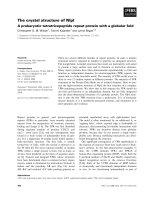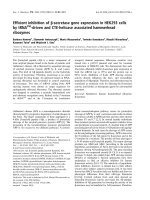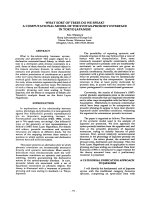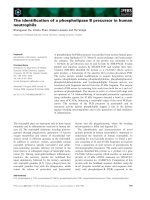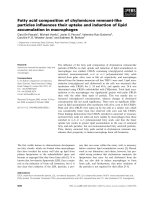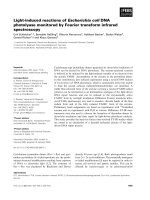Báo cáo khoa học: "Five-year field performance of two types of Douglas fir mini-plug transplants in three forest sites in France" pot
Bạn đang xem bản rút gọn của tài liệu. Xem và tải ngay bản đầy đủ của tài liệu tại đây (788.99 KB, 13 trang )
Original
article
Five-year
field
performance
of
two
types
of
Douglas
fir
mini-plug
transplants
in
three
forest
sites
in
France
Benoit
Généré
Cemagref,
Forest
planting
stock
and
genetic
resources
division,
domaine
des
Barres,
45290
Nogent-sur-Vernisson,
France
(Received
21
October
1997;
accepted
18
February
1998)
Abstract - To
assess
the
respective
abilities
of
two
plant
types
of
Douglas
fir
mini-plug
transplants
(MPT),
namely
MP
+
1 and
MP
+
2,
three
field
trials
were
established
by
Cemagref in
1991
on
sites
with
very
different
soil
fertility
levels.
The
MPT
had
been
grown
at
two
different
nursery
sites,
and
therefore,
were
compared
to
standard
seedlings
from
the
same
nursery,
which
were
I
year
older.
Their
field
performance
was
followed
from
planting
to
age
5,
when
a
complete
assessment
was
made.
The
results
depended
on
both
stock
type
and
planting
site.
MP
+
2
stock
showed
promise,
especially
on
medium
and
low-fertility
soils,
where
the
cumulative
5-year
height
growth
was
increased
by
60
and 80
%,
respectively.
In
contrast,
MP
+
I
stock
performed
less
well
than
its
control
on
all
sites,
and
especially
on
low-fertility
soils
where
the
cumulative
5-year height
growth
was
50
%
less.
More-
over,
on
the
medium-fertility
soil,
severe
wind-throw
occurred
at
age
4
because
of
increased
root
defor-
mities.
The
performance
levels
of both
controls,
grown
in
different
nursery
sites
in
2
or
3
years,
were
actually
rather
similar,
irrespective
of
planting
site
and
seed
source.
(©
Inra/Elsevier,
Paris.)
mini-plug
transplants
/
stock
type
/
Pseudotsuga
menziesii
/
plantation
/
soil
fertility
Résumé -
Performances
de
deux
types
de
plants
repiqués
de
Douglas
issus
de
semis
en
«
mini-
plugs
»,
5
ans
après
plantation
sur
trois
sites
forestiers.
Pour
évaluer
l’intérêt
de
deux
types
de
plants
de
Douglas
semés
en
«
mini-plugs
»
puis
repiqués
(MP
+
1
et
MP
+
2),
trois
essais
en
plantation
ont
été
installés
en
1991
dans
des
stations
à
fertilité
variable.
Ces
deux
types
de
plants
ont
été
produits
sur
des
pépinières
différentes,
avec
un
témoin
local
pour
chacun.
Cinq
ans
après
plantation,
les
résul-
tats
dépendaient
du
type
de
plant
et
du
site
de
plantation.
MP
+
2
a
été
performant,
surtout
sur
les
sols
à
fertilité
moyenne
et
faible
où
la
croissance
cumulée
sur
5
ans
a
été
accrue
de
60
et
80
%,
respecti-
vement.
Inversement,
MP
+
1
a présenté
une
performance
amoindrie,
particulièrement
sur
le
sol
peu
fertile
où
sa
croissance
totale
a
été
réduite
de
50 %.
De
plus,
ses
déformations
racinaires
ont
réduit
sa
résistance
au
vent.
Enfin,
les
performances
des
deux
témoins
ont
été
proches,
quel
que
soit
le
site
de
plantation.
mini-plug
/
type
de
plant
/
Pseudotsuga
menziesii
/
plantation
/
fertilité
du
sol
*
Correspondence
and
reprints
E-mail:
1.
INTRODUCTION
Classic
plug
transplants,
especially
plug
+
ls,
have
been
in
use
in
the
United
States
since
1971
[7]
as
a
way
to
accelerate
nursery
production
and
increase
root
system
fibros-
ity
of bareroot
seedlings. Traditionally,
plug
+
1
seedlings
are
grown
in
a
greenhouse
for
1
year,
then
transplanted
and
grown
in
a
bareroot
nursery
for
an
additional
year
[7,
14].
Since
1983,
a
more
sophisticated
tech-
nique
of
producing
planting
stock
called
’mini-plug
transplant
(MPT)’
has
been
adapted
from
the
agricultural
transplant
industry
and
developed by
Weyerhaeuser
Company
[8].
It
first
focused
on
Douglas
fir
seedlings,
but
was
quickly
extended
to
rooted
cuttings
[12]
and
other
species
[11,
16].
The
MPT
production
cycle
includes
two
parts:
1)
an
early
sowing
or
rooting
phase
in
very
small-cavity
trays
under
a
con-
trolled
greenhouse
environment,
which
gen-
erally
extends
from
January
to
May.
This
is
followed
by
2)
a
transplanting
phase
in
nursery
beds,
which
ends
when
the
plant-
ing
stock
meets
the
required
morphological
standards.
Thus,
production
time
is
often
reduced
by
as
much
as
a
year,
though
this
varies
with
species
and
nursery
locations.
Plug
and
mini-plug
transplants
are
also
known
in
regions
other
than
the
United
States,
especially
in
Canada
[1],
in
South
America
[6]
and
in
Europe.
Here,
MPT
stocks
were
available
from
1988
to
1991,
with
the
establishment
in
the
Netherlands
of
the
European
branch
of
Arborgen,
a
sub-
sidiary
of
Weyerhaeuser
Company.
During
this
period
of
time,
the
mini-plug
starter
crops
were
transplanted
in
different
forest
nurseries
across
Europe, mainly
for
commercial
purposes.
In
collaboration
with
Arborgen-Europe,
Cemagref
was
involved,
first,
in
testing
the
quality
of
different
stocks
of
MPT
produced
in
a
French
State
Forest
nursery
at
Peyrat-le-Château
[3],
and,
sec-
ond,
in
establishing
three
field
trials
with
two
MPT
plant
types
in
Douglas
fir.
The
aim
of
these
experimental
plantations
was
to
determine
whether
two
MPT
stocks,
namely
the
classic
MP
+
I
stock
(produced
within
a
year)
and
the
less
common
MP
+
2
stock
(produced
in
2
years),
each
grown
in
an
appropriate
nursery,
could
be
recommended
for
reforestation
purposes,
in
terms
of
sur-
vival
and
early
growth
potential,
as
com-
pared
to
the
standard
stock
produced
in
each
nursery,
and
which
was
1 year
older
in
both
locations
(1
+
1 and
2
+
1 stocks,
respec-
tively).
The
two
tested
MPT
stocks
are
usually
sown
in
mini-plugs
(MP)
and
grown
until
May
in
a
greenhouse,
then
transplanted
(+)
and
grown
in
a
bareroot
nursery
for
one
growing
season
(MP
+
1 stock)
or
two
addi-
tional
seasons
(MP
+
2
stock).
This
article
reports
the
results
of
these
field
trials
obtained
5
years
after
planting.
Some
early
field
results
from
other
experi-
ments
with
MPT
seedlings
[15]
or
classic
plug
transplants
[1,
9]
are
available
and
gen-
erally
show
positive
or
neutral
effects
com-
pared
to
bareroot
or
plug
controls.
2.
MATERIALS
AND
METHODS
The
three
field
trials
were
established
in
dif-
ferent
regions
of
France
in
1991,
at
Châteldon
(Auvergne),
Saint-Agnant-près-Crocq
(Limousin)
and
Varenguebec
(Normandy
region).
The
planted
Douglas
fir
seedlings
had
been
grown
at
two
nursery
sites:
Préchac
(Aquitaine),
for
MP
+
I and
I +
1 stocks,
and
Peyrat-le-Château
(Limousin)
for
MP
+
2
and
2
+
1 stocks
(figure
1).
2.1.
Field
trials
2.1.1.
Experimental
design
Each
experiment
was
a
randomized
complete
block
design
with four
treatments
(MP
1, 1 +
1,
MP
+
2,
2
+
1 stocks),
four
replicates
and
40
seedlings
(eight
rows
by
five
lines)
per
experi-
ment
unit.
At
least
two
border
lines
were
planted
around
each
trial
in
order
to
avoid
side
effects.
2.1.2.
Planting
site
main features
The
planting
site
at
Châteldon
is
located
at
the
northwestern
edge
of
the
’Livradois-Forez’
mountains
(lat.
45°57.3’N,
long.
3°32’E,
elev.
490-520
m
),
on
a
steep
northerly
slope
(30
%).
The
climate
is
intermediate
with
oceanic,
conti-
nental
and
mountain
influences;
the
annual
rain-
fall
is
800
mm
and
the
mean
temperature
is
9.5
°C.
The
soil,
classified
as
’acid
brown’,
is
quite
deep
(100-120
cm),
and
developed
from
a
quartzo-feldspathic
clayey
sand
(Oligocene
alluvium).
Its
30-cm-deep
upper
soil
texture
is
classified
as
a
loamy
sand,
with
69
%
sand
and
21
%
silt
[10].
The humus
form
is
a
mull-moder.
Vegetation
consists
mainly
of
bramble
(Rubus
fruticosus),
broom
(Cytisus
scoparius)
and
wood
poa
(Poa
nomeralis).
The
planting
site
at
St-Agnant-près-Crocq
is
located
on
the
Millevaches
plateau
(lat.
45°46.7’N,
long.
2°20.1’E,
elev.
780
m),
on
a
slightly
southerly
slope
(7
%).
The
climate
is
classified
as
similar
to
Châteldon’s,
although
colder
and
wetter;
the
annual
rainfall
is
1 070
mm
and
the
mean
temperature
is
7.5
°C.
The
soil
is
80-100
cm
deep,
over
granite
with
biotite.
Its
upper
soil
texture
is
a
loamy
sand,
with
66
%
sand
and
21
%
silt.
The
humus
form
is
an
acid
mull.
The
vegetation
consists
mainly
of
heather
(Calluna
vulgaris)
and
broom
(Cytisus
scopar-
ius).
The
planting
site
at
Varanguebec
is
located
on
the
Cotentin
peninsula
(lat.
49°20.8’N,
long.
1°28’W,
elev.
30
m),
on
flat
ground
inside
a
pri-
vate
wood
(Bois
de
Limors).
The
climate
is
typ-
ically
oceanic;
the
annual
rainfall
is
890
mm
and
the
mean
temperature
is
10.3
°C.
The
soil
is
very
deep
(>
120
cm),
and
being
excessively
damp,
it
has
been
drained.
It
is
classified
as
leached
acid
brown
and
was
formed
over
an
ancient
sand-
stone
bedrock
(Siegenien
period);
its
upper-soil
texture
is
a
clayey
loam
(63
%
silt,
22
%
clay).
The
humus
form
is
a
moder.
The
ground
cover
consists
mainly
of
bracken
(Pteridium
aquil-
inum),
bramble
(Rubus fruticosus),
sheep
sorrel
(Rumex
acetosella)
and
honeysuckle
(Lonicera
periclymenum).
Chemical
soil
analyses
from
the
upper
30
cm
of
all
three
sites
were
performed
in
spring
1994.
Results
are
displayed
in
table
I.
All
the
planting
soils
are
suitable
for
Douglas
fir,
with
an
acid
pH,
sufficient
content
in
organic
matter,
and
an
acceptably
high
cation
exchange
capacity.
The
poorest
soil,
at
St-Agnant,
is
nearly
devoid
of
exchangeable
cations.
Its
cation
satu-
ration
rate,
which
could
be
a
limiting
factor
on
Douglas
fir
growth
[5],
is
only
4
%,
versus
10
%
at
Varanguebec
and
26
%
at
Châteldon.
More-
over,
a
lack
of
phosphorus
appears
on
all
sites,
and
is
more
acute
at
Varanguebec.
Lastly,
the
copper
content
seems
low
at
Châteldon
and
St-
Agnant,
but
probably
is
slightly
above
the
criti-
cal
threshold
because
very
few
stems
were
curved
in
an
S-shape,
5
years
after
planting
[2].
The
site
index
of
these
planting
sites
(i.e.
dom-
inant
tree
height
at
50
years)
is
unknown,
but
target
values
ranging
from
27
to
36
m
are
usual
for
Douglas
fir
in
France
[4].
2.2.
Douglas
fir
seedlings
2.2.1.
Seed
origin
Seeds
from
two
sources
were
used
depending
on
nursery
and
forest
sites.
The
provenance
’Est
Massif
Central
(EMC)’
was
used
at
Châteldon
and
St-Agnant,
for
all
treatments,
and
at
Varangue-
bec,
for
the
plants
grown
at
Préchac.
The
prove-
nance
’Nord-Est’
was
used
at
Varanguebec,
for
the
seedlings
produced
at
Peyrat-le-Château.
Given
the
location
of
the
plantations,
these
provenances
are
recommended
by
the
forest
authorities,
except
EMC
at
Varenguebec.
In
the
latter
case,
’Nord-
Est’
provenance
was
not
available
at
the
Préchac
nursery,
and
it
was
replaced
by
the
provenance
tested
in
the
two
other
sites.
2.2.2.
Nursery
sites
and
growing
conditions
MPT
and
controls
were
grown
in
two
nurs-
eries:
a
State
nursery
at
Peyrat-le-Château
(lat.
45°47.1’N,
long.
1°45.2’E,
elev.
570
m)
and
a
private
nursery,
owned
by
Naudet
Company,
at
Préchac
(lat.
44°23.5’N,
long.
0°20.5’W,
elev.
60
m).
At
Peyrat-le-Château,
the
mean
tem-
perature
is
9.5
°C
and
the
annual
precipitation
is
1 300
mm.
At
Préchac,
the
mean
temperature
is
13 °C
and
the
900
mm
annual
precipitation
is
complemented
by
sprinkler
irrigation.
In
both
nurseries,
the
soils
are
sandy
and
slightly
acid.
Seedling
growth
is
better
at
Préchac
because
of
a
more
favourable
climate
and
intensive
cultural
practices,
so
the
common
growing
cycle
dura-
tion
is
reduced
by
a
year
on
that
site.
On
each
nursery
site,
the
MPT
stocks
were
cultivated
in
a
similar
way
to
the
other
stock
types.
Mini-plug
starter
plants
were
produced
in
a
heated
glasshouse
at
Alsmeer
(the
Netherlands)
from
early
February
to
May,
in
1989
and
in
1990.
They
were
transplanted
by
hand
(using
a
dibble
board)
on
11
May
1989
at
Peyrat-le-Château
and
mechanically
(using
a
mini-plug
transplanting
machine)
on
10
May
1990
at
Préchac.
On
the
lat-
ter
site,
there
was
a
serious
problem
with
plug
integrity,
the
plugs
tending
to
break
up
during
mechanical
planting
(R.
Piesch,
former
manager
of
Arborgen-Europe,
pers.
comm.).
This
resulted
in
1)
many
of
the
seedlings
dropping
out
of
the
tray
sideways,
which
caused
mis-planting,
and
2)
a
need
for
hand-replanting
of
mis-planted
seedlings.
This
was
carried
out
by
manually
push-
ing
the
plugs
back
down
into
the
soil,
which
prob-
ably
caused
undue
stress
and
root
deformation.
Planting
stock
main
features
Initial
height
and
stem
diameter
(measured
at
5
mm
above
the
soil
surface)
depended
on
seed
sources,
stock
types
and
nursery
conditions
(table
II).
They
were
measured
just
after
planting,
so
there
was
probably
an
additional
effect
of
planting
depth,
which
could
partly
account
for
the
initial
height
differences
in
a
given
treatment
between
sites.
Nevertheless,
morphological
vari-
ables
such
as
height,
stem
diameter
and
height-to-
diameter
ratio
(sturdiness)
varied
mainly
with
stock
types.
On
the
one
hand,
MP
+
2
seedlings
had
large
diameters,
and
were
quite
tall
and
sturdy.
In
contrast,
MP
+
1
seedlings
had
small
diameters,
were
short
and
very
sturdy,
but
mean
size
values
were
quite
high
for
this
stock
type
[8].
In
between,
the
I +
1 and
2
+
1 controls
had
intermediate
diameters,
and
were
generally
rather
tall.
The
2
+ 1
seedlings
planted
at
Varanguebec
were
by
far
the
tallest.
All
these
stock
types
met
the
European
mor-
phological
standards
for
Douglas
fir
seedlings.
These
standards
do
not include
any
specification
in
terms
of
quality
of
the
root
systems.
Never-
theless,
a
quick
survey
of
the
planting
material
was
made
at
the
time
of
planting;
it
revealed
fre-
quent
lateral
root
deformations
(mainly
U-shaped
and
twisted
roots)
on
MPT
seedlings,
especially
on
the
younger
MP
+
1s;
these
were
probably
mostly
inherited
from
the
mini-plug
starter
phase.
Moreover,
MP
+
1 stock
had
only
shallow
roots
tracing
near the
soil
surface,
and
that
was
prob-
ably
due
to
the
transplanting
problems.
2.2.4.
Lifting,
handling
and planting
conditions
The
plants
were
lifted
mechanically
on
30
Jan-
uary
1991
at
Préchac
and
on
19
March
1991
at
Peyrat-le-Château.
Just
after
lifting,
the
seedlings
were
quickly
graded
on
the
transplant
beds,
gath-
ered
into
bundles,
and
placed
in
polythene-lined
kraft
paper
bags
which
were
sealed.
The
seedlings
produced
at
Préchac
were
immediately
shipped
and
set
in
cold
storage
(2 °C)
at
the
Naudet
facility
at
Autun
(Burgundy)
until
18
March
1991.
At
this
date, these
seedlings
were
transported
to
Peyrat-le-Château
where
the
four
treatments
were
cold
stored
at
2
°C
until
the
day
before
planting.
During
bed-run
grading,
the
selection
rate
was
similar for
all
stock
types,
with
about
70
%
of
the
seedlings
being
considered
good
for
planting.
On
each
planting
site,
traditional
slit
plant-
ing
with
a
pickaxe
was
performed
by
tree
planters
who
were
local
seasonal
workers;
site
preparation
and
game
protection,
previous
crop,
planting
date
and
spacing,
are
specified
in
table
III.
2.3.
Field
measurements
and
statistical
analysis
2.3.1.
Measurements
All
plants
in
the
test
were
measured
for
height
and
stem
diameter
just
after
planting.
Survival
and
height
were
observed
each
subsequent
year
during
the
first
three
growing
seasons.
At
age
5,
a
complete
assessment
was
made
of
survival,
height
and
diameter
at
1 m
above
ground
line.
At
Varanguebec,
an
additional
final
measure-
ment
was
made
on
wind-stability
because
of
wind-throw
damage
in
January
1995 due
to
exceptional
monthly
rainfall
(260
mm,
mostly
between
17
and 29
January)
and
high-wind
events
(25
days
with
gusts
over
60
km/h,
the
maximum
being
135
km/h
on
the
20th).
After
the
storm,
bent
trees
were
set
upright
and
earthed
up.
On
each
site,
and
for
each
measurement,
game
and
clearing
damage
were
also
recorded
to
exclude
such
plants
from
the
analysis
on
dimensions.
2.3.2.
Statistical
analyses
The
statistical
analyses
were
made
with
’Stat-
graphics
Plus’
for
Windows
software
version
1,
on
individual
values
as
in
the
following.
a)
On
mortality
and
damage
rates,
Chi-square
test
was
used
first
on
all
treatments.
In
case
of
significant
difference
at
the
5
%
level,
the
treat-
ments
were
compared
two
by
two
to
rank them.
Moreover,
the
ranking
of
treatments
was
checked
on
each
block
in
order
to
detect
possible
intcr-
actions
between
blocks
and
treatments.
b)
Height,
diameter
and
growth
were
anal-
ysed
using
analysis
of
variance
(ANOVA).
Its
use
supposes
the
lay-out
to
be
orthogonal
(all
treatments
have
living
and
healthy
plants
in
all
blocks)
and
each
variable
must
meet
the
three
following
assumptions:
normally
distributed
data,
homogeneous
and
independent
treatment
resid-
uals.
If
these
assumptions
were
met
on
treatments
and
on
blocks,
a
two-way
ANOVA
was
per-
formed
using
the
interactive
model.
Sometimes,
data
transformations
were
required.
To
rank
treat-
ments,
the
interaction
between
blocks
and
treat-
ments
had
to
be
either
insignificant
at
the
5
%
level
or
negligible
compared
to
the
treatment
effect.
This
condition
was
always
verified.
After
valid
ANOVA,
all
mean
separations
were
per-
formed
using
Tukey’s
range
test,
at
a
5
%
level.
When
at
least
one
of
the
assumptions
was
not
met,
the
non-parametric
Kruskal-Wallis
test
was
used.
Based
upon
rank
analysis
among
treat-
ments,
it
is
less
precise
than
ANOVA
because
block-treatment
interactions
are
not
taken
into
account.
Nevertheless,
when
significant
differ-
ences
were
detected
at
a
5
%
level,
treatments
were
compared
by
pairs
(Mann-Whitney
test)
for
ranking.
3.
RESULTS
3.1.
Survival
rate
Five
years
after
planting,
survival
was
very
high
on
all
sites
and
for
all
treatments
(table
IV).
Nevertheless,
a
slight
but
signif-
icant
decrease
in
survival
occurred
with
1
+
1
stock
compared
to
all
other
treatments
at
Châteldon,
and
on
2
+
1
and
1
+
1 controls
versus
MP
+
2
stock
at
St-Agnant.
With
1
+
1
stock,
these
differences
in
survival
appeared
as
early
as
the
planting
year,
and
may
have been
associated
with
transplanting
shock.
With
the
2
+
1
stock,
a
significant
difference
appeared
between
the
third
and
the
fifth
year
after
planting,
and
was
unex-
plained.
3.2.
Five-year
height
The
highest
values
were
obtained
at
Châteldon
and
the
lowest
at
St-Agnant,
Varanguebec
being
intermediate.
The
dif-
ferences
among
treatments
were
large.
Saplings
grown
in
the
same
nursery
were
compared
first.
On
the
one
hand,
MP
+
I
stock
was
significantly
smaller
than
its
1
+
1
control
while,
on
the
other
hand,
MP
+
2
stock
was
larger
than
its
2
+
1
control.
These
observations
apply
to
all
three
planting
sites,
but
differences
between
treatments
decrease
in
both
absolute
and
relative
values
with
mean
height
(i.e.
with
soil
fertility).
As
a
result,
if
we
compare
the
extreme
mean
val-
ues
at
age
5,
MP
+
I
height
represents
only
36
%
of
MP
+
2
height
at
St-Agnant,
but
94
%
at
Châteldon.
Regarding
the
1 + 1
and
2
+
1
standards,
their
mean
height
values
were
similar
at
Châteldon
and
St-Agnant,
when
the
same
seed
source
was
used
(EMC),
and
differed
slightly
at
Varanguebec,
where
seed
sources
were
different.
An
additional
investigation
was
made
on
the
possible
relationships
between
final
height
and
initial
dimensions
(i.e.
height,
stem
diameter
and
sturdiness),
on
individual
values
for
each
site.
Regression
coefficients
(r)
from
the
best
predictive
models
were
lower
than
0.60,
in
all
cases,
and
overall
variance
was
always
mostly
due
to
differ-
ences
between
treatments.
3.3.
Cumulative
5-year
height
growth
The
results
are
presented
in figure
2.
Across
sites,
they
coincide
with
5-year
height:
growth
was
better
at
Châteldon
and
poorer
at
St-Agnant,
Varanguebec
being
in
between.
Among
treatments,
two
statistical
differences
in
height
disappeared
for
growth
because
mean
heights
differed
at
planting.
Thus,
for
5-year
growth,
MP
+
2
equalled
2
+
1 at
Châteldon
and
MP
+
I
equalled
1 +
I
at
Varanguebec.
All
other
results
were
similar
to
those
for
5-year
height.
3.4.
Height
growth
kinetics
Growth
kinetics
depended
on
sites
and
treatments
(figure
3).
Planting
sites
mainly
influenced
the
form
of
the
growing
curve
whereas
the
range
of
values
varied
each
year
with
treatments.
Across
sites,
at
Châteldon,
the
growth
rate
increased
during
the
first
3
years
after
planting,
reached
a
peak
at
age
3,
and
decreased
slightly
during
the
next
two
grow-
ing
seasons.
At
Varanguebec,
the
results
were
similar,
but
2nd-year
and
3rd-year
growth
rates
were
very
similar.
At
St-
Agnant,
the
annual
growth
rate
kept
increas-
ing
during
the
first
five
growing
seasons,
so
that
the
final
values
were
close
to
those
of
Varanguebec.
Among
treatments,
growth
kinetics
var-
ied
with
site.
At
Châteldon,
1st-year
growth
was
greater
by
7
cm
for
seedlings
grown
at
Préchac
(1
+
1 and
MP
+
1).
This
trend
dis-
appeared
completely
in
the
following
years.
Thus,
at
ages
2
and
3,
the
annual
growth
was
greater
on
MP
+
2
versus
all
other
treatments.
At
age
3,
the
MP
+
1 stock
had
significantly
slower
growth.
During
the
4th
and
5th
years,
MP
+
I
had
a
slower
growth
than
only
the
2
+
1.
At
St-Agnant,
only
MP
+
2
had
the
best
growth
every
year,
except
in
the
first
year
when
it
shared
this
rank
with
1 +
1.
Con-
versely,
only
MP
+
I
stock
had
the
lowest
performance
every
year.
In
between,
1
+
I
performed
better
than
2
+
1
during
the
first
2
years,
and
equally,
afterwards.
At
Varanguebec,
on
seedlings
reared
at
Peyrat-le-Château,
MP
+
2
stock
grew
bet-
ter
than
the 2
+
1
control
every
year.
On
coming
from
Préchac,
MP
+
1
annual
growth
was
statistically
the
same
as
that
of
its
1
+
1
control
at
age
1
and
age
3,
but
it
was
better
at
age
2
and
slower
at
age
4-5.
Moreover,
the
growth
curves
of
the
two
controls
(1 +
1 and
2 + 1)
were
very
similar,
1 + 1
being
slightly
greater
than
2
+
1
with
an
early
significant
difference
which
disap-
peared
at
age
4-5.
3.4.1.
Stem
diameter
at
1
m
above
ground
line
at
age
5
This
measurement
was
taken
only
on
trees
which
were
over
1.2
m
high,
whose
numbers
varied
considerably
with
site
and
treatment.
The
results
are
shown
in
table
IV.
To
eliminate
sample-size
bias
when
com-
paring
mean
stock
diameters,
similar
num-
bers
of
measured
trees
were
needed.
At
Châteldon
and
Varanguebec,
most
of
the
trees
were
measured,
but
not
at
St-Agnant.
At
Châteldon,
the
diameter
was
greater
on
controls
than
on
MPT,
irrespective
of
the
nursery
site;
the
result
was
not
linked
to
height
differences
but
to
sapling
sturdiness.
Moreover,
MP
+
1
mean
diameter
was
lower
than
for
MP
+
2,
but
the
difference
was
mainly
due
to
a
shorter
height.
At
St-Agnant,
the
results
showed
that
the
two
controls
(2
+
1
and
1
+
1)
performed
the
same
in
diameter
as
in
height.
With
MPT,
mean
diameter
was
influenced
by
the
number
of
measured
trees
and
by
their
mean
height,
which
were
both
very
different
between
the
two
stock
types
and
also
versus
controls.
At
Varanguebec,
all
treatments
differed
significantly.
Their
ranking
was
the
same
as
for
height,
but
MP
+
1
behaved
the
poor-
est,
probably
because
of
increased
wind-
throw
damage.
3.4.2.
Wind-throw
and
root
deformity
analyses
at
Varanguebec
High
rainfall
and
high
winds
accounted
in
part
for
wind-throw
at
Varanguebec,
in
the
fifth
year
after
planting.
Nevertheless,
pro-
portion
of
wind-blown
trees
depended
on
treatments:
23
%
on
MP
+
1, 20
%
on
2
+
1,
13
%
on
I
+
1
and
5
%
on
MP
+
2.
A
Chi-
square
test
showed
that
meaningful
differ-
ences
appeared
first
between
MP
+
2
which
was
relatively
wind-resistant,
and
all
other
treatments,
and
second,
between
1 +
1 (inter-
mediate
behaviour)
and
MP
+
1
which
was
severely
damaged.
The
sensitivity
to
blow-
down
damage
differed
with
treatments
and
could
have been
associated
with
root
defor-
mation.
A
sample
of
ten
representative
saplings
per
treatment
was
excavated
on
15
Novem-
ber
1995
from
an
additional
plot
established
for
destructive
analyses.
The
root
deformi-
ties
of
these
trees
were
assessed.
The
results
revealed
that
the
roots
present
at
planting
had
often
been
compressed
into
a
flat
plane.
In
addition,
the
taproot
of
numerous
seedlings
appeared
to
have
been
bent
(J-
rooted),
especially
for
2
+
1s
which
were
longer,
at
the
time
of
planting.
At
age
5,
only
MP
+
2
seedlings
were
well-anchored
because
they
had
developed
a
symmetrical
array
of
sturdy
roots.
By
contrast,
MP
+
1
stock
very
often
revealed
a
poor
and
shallow
root
system,
with
also
some
spiralled
or
kinked
roots.
4.
DISCUSSION
The
two
types
of
MPT
tested
in
the
three
forest
sites
performed
very
differently
across
the
sites,
between
themselves
and
also
com-
pared
to
their
own
control
groups,
which
originated
from
the
same
seed
source
and
which
were
grown
in
the
same
nursery.
The
MP
+
2
stock
produced
at
Peyrat-le-
Château
showed
promise:
on
low
and
medium-fertility
soils
(St-Agnant
and
Varanguebec,
respectively),
it
survived
very
well,
had
by
far
the
highest
5-year
cumula-
tive
growth
and
5-year
height
among
treat-
ments,
and
consequently
the
best
diameter
at
1
m
above
ground
line
at
age
5.
On
a
high-
fertility
soil
(Châteldon),
its
5-year
cumu-
lative
growth
improved
but
did
not
differ
from
that
of
two
other
treatments
(2
+
1
and
1 + 1);
its
diameter
at
1
m
above
the
ground
at
age
5
was
even
slightly
less
than
that
of
its
2 +
1 control,
but
survival
was
unaffected.
Thus,
even
if
these
MP
+
2
saplings
were
more
slender
on
the
latter
site,
their
future
is
promising,
because
5
years
after
planting
the
root
system
was
probably
well-anchored
as
at
Varanguebec.
To
conclude
on
MP
+
2,
its
use
seems
appropriate
on
all
sites;
fur-
thermore,
the
poorer
the
soil,
the
higher
the
gain
over
control.
The
MP
+
1 stock
grown
at
the
nursery
of
Préchac
was
disappointing.
Its
performance
was
generally
low
on
all
planting
sites
com-
pared
to
its
1
+
1
control.
At
St-Agnant,
on
a
low-fertility
soil,
the
growth
of
the
MP
+
1
stock
since
planting
has
been
so
poor
that
it
leads
us
to
question
their
suitability
for
reforestation
purposes.
At
Varanguebec
and
Châteldon,
on
medium-
and
high-fertility
soils,
respectively,
a
slight
but
significant
decrease
in
5-year
height
and
diameter
at
1
m
above
ground
line
was
observed.
Cumu-
lative
height
growth
was
also
affected
at
Châteldon,
from
the
third
year
after
planting
but
not
at
Varanguebec.
On
the
latter
site,
the
MP
+
1
height
growth
was
even
enhanced
at
age
2
but,
during
years
4-5,
the
wind-throw
damage
which
was
more
acute
on
this
treatment,
led
to
a
levelling
off
of
growth
performance.
Root
deformities
were
shown
to
be
an
additional
problem
on
MP
+
1,
which
could be
partly
inherited
from
the
transplanting
problems.
The
only
meaning-
ful
advantage
of
MP
+
1 over
its
1
+
1
con-
trol
was
to
increase
survival
by
6
%
at
Châteldon,
but
this
is
not
of
practical
impor-
tance
to
foresters.
Nevertheless,
this
slight
gain
in
survival
might
be
linked
to
a
better
water
stress
tolerance
during
planting
shock
[13].
To
conclude
with
MP
+
1 seedlings,
we
must
emphasize
that
they
were
the
small-
est
at
planting,
even
if
larger
than
usual
for
this
stock
type
[8],
and
they
did
not
fully
meet
the
French
morphological
standards
(minimum
height:
25
cm),
even
if
their
stur-
diness
was
adequate.
This
smaller
size
should
not
have
depressed
cumulated
growth
[15],
even
on
a
skeletal
soil
[9];
the
absence
of
correlation
between
initial
seedling
sizes
(height,
diameter
and
height
to
diameter
ratio)
and
final
height
was
checked
on
each
field
trial.
Both
controls,
2
+
1
and
1 + 1,
behaved
similarly
at
age
5,
at
Châteldon
and
St-
Agnant
where
they
originated
from
the
same
seed
source.
A
slight
but
significant
differ-
ence
was
observed
at
Varenguebec,
proba-
bly
because
the
two
stock
types
were
of
dif-
ferent
provenances.
There
was
no
evidence
of
a
nursery
site
effect
on
performance
5
years
after
planting,
so
that
the
only
known
effect
was
on
the
duration
of
the
growing
period
(2
years
at
Préchac
versus
3
years
at
Peyrat-le-Château).
In
the
absence
of
proven
nursery
site
effects
on
controls,
the
high
performance
of
MP
+
2
stock
as
compared
to
the
poor
behaviour
of
MP
+
1
stock
was
a
surprise
which
needs
to
be
explained.
Poor
plug
integrity
during
mechanical
transplanting
at
Préchac
resulted
in
most
seedlings
having
to
be
re-planted
by
hand.
This
probably
caused
increased
root
deformities
and
lack
of
anchor
roots,
still
visible
5
years
after
planting,
at
Varanguebec.
The
same
reason
could
explain
the
poor
field
performance
of
MP
+
1 stock
5
years
after
planting,
espe-
cially
on
nutrient-depressed
soils.
The
fact
that
the
MP
+
2
stock
did
exceptionally
well
in
the
field
suggests
that
the
MPT
concept
is
viable
if
the
stock
is
transplanted
and
grown
properly
in
the
nursery.
On
a
commercial
scale,
production
costs
of MPT
stocks
are
relatively
low
[15],
MP
+
1
s being
currently
similar
to
those
of
1
+
1
stock,
and
MP
+
2s
being
probably
similar
to
those
of
2
+
1
stock.
Keeping
costs
low
implies
a
high
degree
of
mechanization
and
success
in
the
operations,
especially
for
transplanting,
which
was
not
experienced
in
this
study.
ACKNOWLEDGEMENTS
The
author
wishes
to
thank
Jean-Michel
Ami-
rault,
from
Cemagref,
for
his
technical
assis-
tance,
Richard
Piesch,
Barbara
and
David
Thompson,
former
managers
of
Arborgen-
Europe,
for
their
large
contribution
on
producing
MPT,
for
their
support
for
field
establishment,
and
for
their
comments
on
the
manuscript.
Thanks
also
to
the
Naudet
Company,
to
the
State
forest
nursery
at
Peyrat-le-Château
and
to
the
private
land
owners
and
foresters
associated
with
the
study.
REFERENCES
[1]
Arnott
J.T.,
Pendl
F.T.,
Field
performance
of
several
tree
species
and
stock
types
planted
in
mon-
tane
forests
of
coastal
British
Columbia,
Information
Rep.,
Can.
For.
Serv.,
no.
BC-X-347,
1994, 45
p.
[2]
Bonneau
M.,
Causes
de
la
deformation
des
jeunes
Douglas
dans
le
Limousin,
Ann.
Sci.
For.
28
(1971) 341-353.
[3]
Cemagref,
Results
of
Plug
Trials
1989,
Tech.
Rep.,
Cemagref,
Nogent-sur-Vernisson,
1993,
12 p.
[4]
de
Champs
J.,
Le
Douglas,
Afocel,
Paris,
1997,
416 p.
[5]
Gilbert
J.M.,
Stations
forestières
et
production
du
Douglas
dans
le
pays
d’Othe,
Rev.
For.
Fr.
47
(1995)
343-356.
[6]
Gonda
H.,
Mondino
V.,
Production
of
acceler-
ated
transplants
of
Ponderosa
pine
and
Douglas
fir
in
the
Patagonian
Andes,
in:
OFRI
(Eds.),
Abstracts
of
’Making
the
Grade’,
Int.
Symp.,
11-15
September
1994,
Sault-Ste-Marie,
Ontario,
Canada,
1994,
p.
51.
[7]
Hahn
P.F.,
Plug
+
1 seedling
production,
in:
Duryea
M.L.,
Landis
T.D.
(Eds.),
Forest
Nursery
Man-
ual:
Production
of
Bareroot
Seedlings,
M.
Nijhoff/Dr
W.
Junk
Publ.,
The
Hague,
1984,
pp.
165-181.
[8]
Hee
S.M.,
Stevens
T.S.,
Walch
D.C.,
Production
aspects
of
mini-plug
transplants,
in:
Proc.
Combined
Meeting
of
the
Western
Forest
Nursery
Assoc.,
8-11
August
1988,
Vernon,
British
Columbia,
Canada,
Gen.
Tech.
Rep.
RM-167,
USDA
For.
Serv.,
1990,
pp.
168-171.
[9]
Hobbs
S.D.,
Crawford
M.S.,
Yelczyn
B.A.,
Early
development
of
three
Douglas
fir
stock
types
on
a
droughty
skeletal
soil,
West.
J.
Appl.
For.
4
(1989)
21-24.
[10]
Jamagne
M.,
Bases
et
techniques
d’une
car-
tographie
des
sols,
Ann.
Agro.
18
(hors-série)
(1967)
142 p.
[11]
Mc
Creary
D.,
Lippitt
L.,
Producing
blue
oak
seedlings:
comparing
mini-plug
transplants
to
stan-
dard
bareroot
and
container
stock,
in:
Gen.
Tech.
Rep.
PNW-GTR-389,
USDA
For.
Serv.,
1997,
pp.
253-254.
[ 12]
Ritchie
G.A.,
Tanaka
Y.,
Duke
S.D.,
Physi-
ology
and
morphology
of
Douglas
fir
rooted
cuttings
compared
to
seedlings
and
transplants,
Tree
Physiol.
10
(1992) 179-194.
[13]
Rose
R.,
Gleason
J.F.,
Atkinson
M.,
Morpho-
logical
and
water-stress
characteristics
of
three
Douglas
fir
stocktypes
in
relation
to
seedling
performance
under
different
soil
moisture
conditions,
New
For.
7
(1993)
1-17.
[14]
Schalla
S.L.,
Doughton
K.,
Transplanting
the
Douglas
fir
plug,
in:
Combined
Proc.
International
Plant
Propagators’
Society,
USA,
vol.
28, 1978,
pp. 177-184.
[15]
Tanaka
Y.,
Carrier
B.,
Dobkowski
A.,
Figueroa
P.,
Meade
R.,
Field
performance
of
mini-
plug
transplants,
in:
Proc.
Combined
Meeting
of
the
Western
Forest
Nursery
Assoc.,
8-11
August
1988,
Vernon,
British
Columbia,
Canada,
Gen.
Tech.
Rep.
RM-167,
USDA
For.
Serv.,
1990,
pp.
172-181.
[16]
Tinus
R.W.,
A
Trial
of
Plug
Transplant
Seedling
Production
in
the
Southwest,
West.
J.
Appl.
For.
11
(1996) 81-84.



